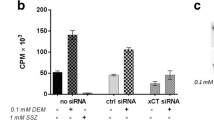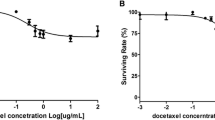Abstract
Objective
Technetium-99m sestamibi (MIBI) has been utilized to evaluate multi-drug resistance (MDR) phenomenon of malignant tumors and to predict chemotherapeutic effects on them. The current investigation examined the possibility of monitoring changes with respect to mRNA expression of multi-drug resistance associated protein (MRP) following antisense oligodeoxynucleotide (AS-ODN) treatment involving99mTc-MIBI.
Methods
The human breast cancer MCF-7 cell line and its MDR-induced MCF-7/VP cell line were employed. Cell suspensions of the two cell lines at 1 x 104 cells/m/ were inoculated in 24-well plates (0.2 ml/well) and incubated for one day. Antisense (AS) 20-mer phosphorothioate ODN complementary to the coding region of MRP mRNA and its sense (S) ODN were administered at final concentrations up to 25 μM, followed by a 5-day incubation.99mTc-MIBI solution was added to each well and incubated for 30 min. Cellular99mTc-MIBI uptake was corrected for protein concentration. MRP mRNA expression levels were analyzed via the reverse transcription Polymerase chain reaction (RT-PCR).
Results
Cellular uptake of99mTc-MIBI in MCF-7/VP cells was only 15% of that of MCF-7 cells. Following AS-ODN treatment at 25 μM for five days,99mTc-MIBI uptake in MCF-7/VP cells increased 2.4-fold in comparison with non-treated control cells.99mTc-MIBI uptake in MCF-7 cells was unaffected by AS-ODN administration. Sense ODN did not alter uptake in either cell line. RT-PCR confirmed reduction of MRP mRNA in MCF-7/VP cells following AS-ODN treatment.
Conclusion
Effects of AS-ODN administration on MRP function can be monitored via assessment of cellular uptake of99mTc-MIBI.
Similar content being viewed by others
References
Kuwano M, Uchiumi T, Hayakawa H, Ono M, Wada M, Izumi H, et al. The basic and clinical implications of ABC transporters, Y-box-binding protein-1 (YB-1) and angio-genesis-related factors in human malignancies.Cancer Sci 2003; 94: 9–14.
Bates SF, Chen C, Robey R, Kang M, Figg WD, Fojo T. Reversal of multidrug resistance: lessons from clinical oncology.Novartis Found Symp 2002; 243: 83–89.
Wang RB, Kuo CL, Lien LL, Lien EJ. Structure-activity relationship: analyses of p-glycoprotein substrates and inhibitors.J Clin Pharm Ther 2003; 28: 203–228.
Fojo T, Bates S. Strategies for reversing drug resistance.Oncogene 2003; 22: 7512–7523.
Kobayashi H, Takemura Y, Miyachi H. Novel approaches to reversing anti-cancer drug resistance using gene-specific therapeutics.Hum Cell 2001; 14: 172–184.
Ballinger JR. Imaging multidrug resistance with radio-labeled substrates for P-glycoprotein and multidrug resistance protein.Cancer Mother Ratiopharm 2001; 16:1–7.
Ballinger JR, Hua HA, Berry BW, Firby P, Boxen I.99mTc-sestamibi as an agent for imaging P-glycoprotein-mediated multi-drug resistance:in vitro andin vivo studies in a rat breast tumour cell line and its doxorubicin-resistant variant.Nucl Med Commun 1995; 16: 253–257.
Luker GD, Fracasso PM, Dobkin J, Piwnica-Worms D. Modulation of the multidrug resistance P-glycoprotein: detection with technetium-99m-sestamibiin vivo.J Nucl Med 1997; 38: 369–372.
Ballinger JR, Muzzammil T, Moore MJ. Technetium-99m-furifosmin as an agent for functional imaging of multidrug resistance in tumors.J Nucl Med 1997; 38: 1915–1919.
Muzzammil T, Ballinger JR, Moore MJ.99mTc-sestamibi imaging of inhibition of the multidrug resistance transporter in a mouse xenograft model of human breast cancer.Nucl Med Commun 1999; 20: 115–122.
Cayre A, Moins N, Finat-Duclos F, Maublant J, Verrelle P. Comparative99mTc-sestamibi and3H-daunomycin uptake in human carcinoma cells: relation to the MDR phenotype and effects of reversing agents.J Nucl Med 1999; 40: 672- 676.
Muzzammil T, Moore MJ, Ballinger JR.In vitro comparison of sestamibi, tetrofosmin, and furifosmin as agents for functional imaging of multidrug resistance in tumors.Cancer Biother Ratiopharm 2000; 15: 339–346.
Tatsumi M, Tsuruo T, Nishimura T. Evaluation of MS-209, a novel multidrug-resistance-reversing agent, in tumour-bearing mice by technetium-99m-MIBI imaging.Eur J Nucl Med Mol Imaging 2002; 29: 288–294.
Diah SK, Smitherman PK, Aldridge J, Volk EL, Schnider E, Townsend AJ, et al. Resistance of mitoxantrone in multi-drug-resistant MCF7 breast cancer cells: evaluation of mitoxantrone transporter and the role of multidrug resistance protein family proteins.Cancer Res 2001; 61: 5461–5467.
Kinuya S, Li XF, Yokoyama K, Mori H, Shiba K, Watanabe N, et al. Reduction of99mTc-sestamibi and99mTc-tetrofosmin uptake in MRP-expressing breast cancer cells under hy-poxic conditions is independent of MRP function.Eur J Nucl Med Mol Imaging 2003; 30: 1529–1531.
Stewart AJ, Canitrot Y, Baracchini E, Dean NM, Deeley RG, Cole SP. Reduction of expression of the multidrug resistance protein (MRP) in human tumor cells by antisense phosphorothioate oligonucleotides.Biochem Pharmacol 1996;51:461–469.
Wang H, Chen XP, Qiu FZ. Correlation of expression of multidrug resistance protein and messenger RNA with99mTc-methoxyisobutyl isonitrile (M1BI) imaging in patients with hepatocellular carcinoma.World J Gastroenterol 2004; 10: 1281–1285.
Kunishio K, Morisaki K, Matsumoto Y, Nagao S, Nishiyama Y. Technetium-99m sestamibi single photon emission computed tomography findings correlated with P-glycoprotein expression, encoded by the multidrug resistance gene-1 messenger ribonucleic acid, in intracranial meningiomas.Neurol Med Chir (Tokyo) 2003; 43: 573–580.
Zhou J, Higashi K, Ueda Y, Kodama Y, Guo D, Jisaki F, et al. Expression of multidrug resistance protein and messenger RNA correlates with99mTc-MIBl imaging in patients with lung cancer.J Nucl Med 2001; 42: 1476–1483.
Kinuya S, Yokoyama K, Li XF, Bai J, Watanabe N, Shuke N, et al. Hypoxia-induced alteration of tracer accumulation in cultured cancer cells and xenografts in mice: implications for pre-therapeutic prediction of treatment outcomes with99mTc-sestamibi,201T1 chloride and99mTc-HL91.Eur J Nucl Med Mol Imaging 2002; 29: 1006–1011.
Nakamura K, Kubo A, Hnatowich DJ. Antisense targeting of p-glycoprotein expression in tissue culture.J Nucl Med 2005;46:509–513.
Almquist KC, Loe DW, Hipfner DR, Mackie JE, Cole SP, Deeley RG. Characterization of the M(r) 190,000 multidrug resistance protein (MRP) in drug-selected and transfected human tumor cell.Cancer Res 1995; 55: 102–110.
Arbab AS, Koizumi K, Toyama K, Araki T. Uptake of technetium-99m-tetrofosmin, technetium-99m-MIBI and thallium-201 in tumor cell lines.J Nucl Med 1996; 37:1551–1556.
Arbab AS, Koizumi K, Toyama K, Arai T, Araki T. Tech-netium-99m-tetrofosmin, technetium-99m-MIBI and thallium-201 uptake in rat myocardial cells.J Nucl Med 1998;39:266–271.
Arbab AS, Koizumi K, Toyama K, Arai T, Araki T. Effects of ion channel modulators in the influx and efflux of Tc-99m-MIBl.Ann Nucl Med 1999; 13: 27–32.
Arbab AS, Ueki J, Koizumi K, Araki T. Effects of extracellular Na+ and Ca2+ ions and Ca2+ channel modulators on the cell-associated activity of99mTc-MIBI and99mTc-tetrofosmin in tumour cells.Nucl Med Commun 2003; 24:155–166.
Cohen JS. Phosphorothioate oligodeoxynucleotides. In:Antisense research and applications, Crooke ST, Lebleu B (eds), New York; CRC Press, 1993: 205–221.
Loke SL, Stein CA, Zhang XH, Mori K, Nakanishi M, Subasinghe C, et al. Characterization of oligonucleotide transport into living cells.Proc Natl Acad Sci USA 1989; 86:3474–3478.
Bai J, Yokoyama K, Kinuya S, Shiba K, Matsushita R, Nomura M, et al.In vitro detection ofmdrl mRNA in murine leukemia cells with111In-labeled oligonucleotide.Eur J Nucl Med Mol Imaging 2004; 31: 1523–1529.
Hart J, Wilkinson MF, Kelly ME, Barnes S. Inhibitory action of diltiazem on voltage-gated calcium channels in cone photoreceptors.Exp Eye Res 2003; 76: 597–604.
Su Z, Sugishita K, Li F, Ritter M, Barry WH. Effects of FK506 on [Ca2+]i differ in mouse and rabbit ventricular myocytes.J Pharmacol Exp Ther 2003; 304: 334–341.
Thami GP, Bhalla M. Erythromelalgia induced by possible calcium channel blockade by cyclosporin.BMJ 2003; 326:910.
Author information
Authors and Affiliations
Corresponding author
Rights and permissions
About this article
Cite this article
Kinuya, S., Bai, J., Shiba, K. et al. 99mTc-sestamibi to monitor treatment with antisense oligodeoxynucleotide complementary to MRP mRNA in human breast cancer cells. Ann Nucl Med 20, 29–34 (2006). https://doi.org/10.1007/BF02985587
Received:
Accepted:
Issue Date:
DOI: https://doi.org/10.1007/BF02985587




